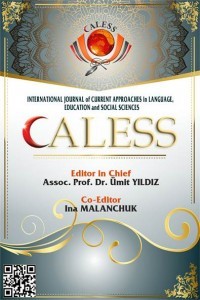FRANSIZCA VE NÜBYENİN KARŞITSAL ÇÖZÜMLEMESİ: AD ÖBEĞİ YAPILARI
Karşıtsal Çözümleme, Ad Öbeği Yapıları, Fransızca, Nübye, Basit ve Karmaşık Ad Öbekleri
CONTRASTIVE ANALYSIS OF FRENCH AND NUBIAN: NOUN PHRASE CONSTRUCTIONS
Contrastive Study, Noun Phrase Constructions, French Language, Nubian Language, Simple and Complex Noun Phrases,
___
- Alamin, S. (2014). Noun phrase constructions in Nubian languages: A comparative study. Dotawo: A Journal of Nubian Studies, 1(10), 203-220.
- Alfaki, I. M. (2014). A contrastive study in sentence construction between English and Nubian Languages. American International Journal of Contemporary Research, 4(5), 137-147.
- Bada, E. (2001). Native language influence on the production of English sounds by Japanese learners. The Reading Matrix, 1(2), 1-15.
- Bouveret, M., & Legallois, D. (Eds.). (2012). Constructions in French (pp.9). Amsterdam/Philadelphia: John Benjamins Publishing Company.
- De Wit, A., Patard, A., & Brisard, F. (2013). A contrastive analysis of the present progressive in French and English. Studies in Language, 37(4), 846-879.
- Chen, K. (1997). English vs Chinese: World views and writing styles. TESOL Matters, 7, 1-13.
- Fries, C.C. (1945). Teaching and learning English as a foreign language. Michigan: University of Michigan Press.
- Hamel, N. (1925). A new universal French grammar; being an accurate system of French accidence and syntax, on a methodological plan (pp: 127). London: A. & R. Spottiswoode, New-Street-Square.
- Krzeszowski, T. P. (1990). Contrasting languages: The scope of contrastive linguistics. Walter de Gruyter.
- Lado, R. (1957). Linguistics across culture: Applied linguistics for language teaching. Michigan: University of Michigan Press.
- Lodge, R. A., Armstrong, N. Ellis, Y. M. L., & Shelton, J.F. (1997). Exploring the French language (pp.146). London: John Wiley & Sons.
- N'Gom, F. (1997). Contrastive phonological analysis of French and Mandinka (Master’s thesis, University of Montana).
- Odudigbo, M. E. (2014). Contrastive Analysis of French and Yoruba Language. Nigerian Defence Academy, Nigeria.
- Payne, J.R. (2006). Noun phrases. In K. Brown (Ed.), Encyclopedia of language and linguistics (pp. 712-20). Amsterdam: Elsevier.
- Rowlett, P. (2007). The syntax of French (pp.17). Cambridge University Press.
- Salim, A. (1991). A Contrastive analysis between the French noun phrase and the English noun phrase (Doctoral dissertation, Southern Illinois University).
- Siméus, M. A. (2017). French made simple: Synthesis of grammar. Bloomington: AuthorHouse.
- Sallee, B. and Hebert, D. (2014). The everything essential French book: All you need to learn French in no time (p.155). Massachuets: Simon & Schuster, Inc.
- Tajareh, M. J. (2015). An overview of contrastive analysis hypothesis. Cumhuriyet Üniversitesi Fen-Edebiyat Fakültesi Fen Bilimleri Dergisi, 36(3), 1106-1113.
- Thomas, J. (1983). Cross-cultural pragmatic failure. Applied Linguistics, 4, 91.
- Vaillant, P. (2016). Noun phrases in mixed Martinican Creole and French: Evidence for an underspecified language model. Retrieved from https://hal.archives-ouvertes.fr/hal-01451392.
- Walid, M. C. M. (2012). English and French phonological systems: A contrastive study (Doctoral Dissertation, Unıversıté Badji Mokhtar-Annaba).
- Weinreich, V. (1953). Languages in contact. New York: Linguistic Circles of NY.
- ISSN: 2687-2528
- Yayın Aralığı: Yılda 2 Sayı
- Başlangıç: 2019
- Yayıncı: Ümit YILDIZ
AFFETME: KURAMSAL BİR DEĞERLENDİRME
TÜRKÇEDE KISA ÇİZGİNİN KULLANIM YERLERİNE EKLER
ERGENLERİN TOPLUMSAL CİNSİYET EŞİTLİĞİNE İLİŞKİN TUTUMLARININ BELİRLENMESİ: ESKİŞEHİR ÖRNEĞİ
Deniz TÜRKMEN, Gökhan ALPTEKİN
İLKOKULA HAZIRBULUNUŞLUK ÖLÇEĞİ: YAPISAL GÜÇLENDİRME ÇALIŞMASI
Tuncay CANBULAT, Halit KIRIKTAŞ, İbrahim Hakkı TEZCİ, Elif İLHAN
FRANSIZCA VE NÜBYENİN KARŞITSAL ÇÖZÜMLEMESİ: AD ÖBEĞİ YAPILARI
BIRSEY WUMAR VE İVAN KRİLOV'UN FABLLARINA KARŞILAŞTIRMALI BİR BAKIŞ
ÖZ-ŞEFKAT GELİŞİMİNDE BİLİŞSEL FORMÜLASYONUN ROLÜ
NASRETTİN HOCA ZAMAN YOLCUSU: SÖZLÜ, YAZILI VE ELEKTRONİK KÜLTÜR METİNLERİ ARASINDA BİR ÇİZGİ DİZİ
